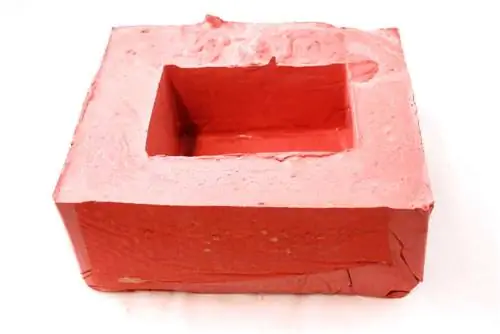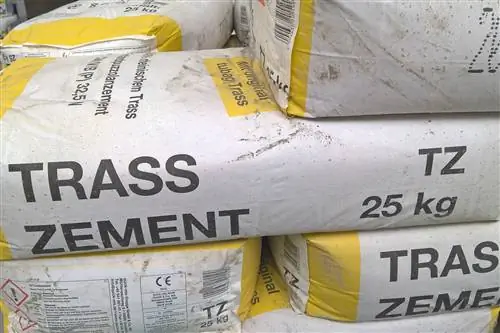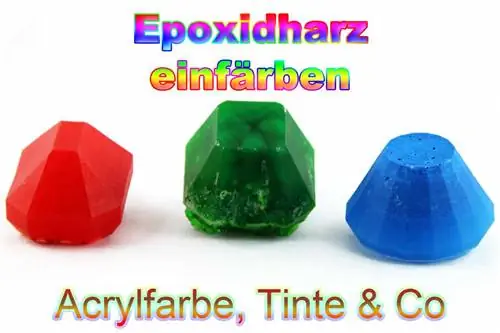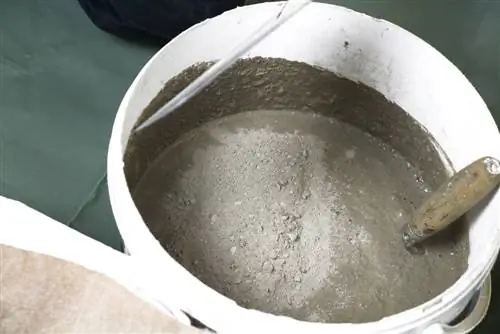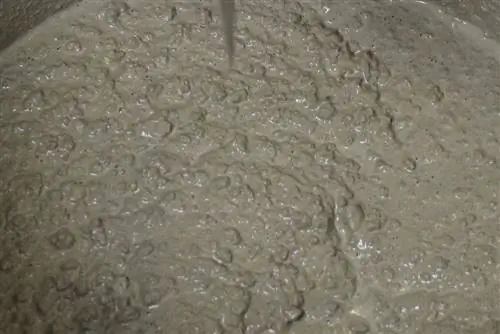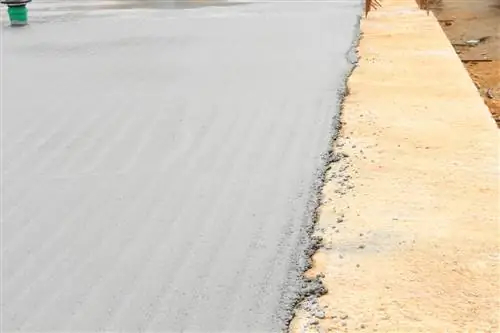- Author admin [email protected].
- Public 2023-12-17 03:39.
- Last modified 2025-06-01 06:48.
Concrete is considered grey, massive and simply unattractive. But it does not have to be like this. While modern technology enables increasingly organic and slimmer concrete forms, you can take a different approach even for your private projects: How about an alternative to the dreary gray? We explain which methods and work steps you can use to specifically color concrete.
Why gray?
Why should you even consider coloring your concrete yourself? Can't the manufacturers do this directly? It doesn't always have to be gray. Well, it doesn't always have to be gray, but unless you make any extra effort, this color is and will always be reserved for concrete. The reason is the most important ingredient in concrete: cement. In addition to a few other additives, it is primarily made from limestone and clay, which occurs naturally in the form of a mixture usually known as “marl”. The raw materials are burned at almost 1,500 degrees Celsius above the so-called sintering limit and then ground into the familiar powder. Both the raw materials themselves and the firing process lead to the familiar, unappealing color.
How to change concrete color?
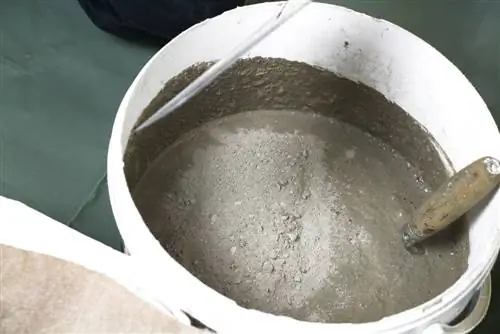
Various manufacturers have also recognized that additional colors increase diversity and make concrete interesting for people who want to avoid the uniform gray. For large quantities of concrete, such as when building a house, you should leave the coloring to the professionals. However, if you need smaller amounts of concrete for garden walls, planters or craft work, you can create the desired color yourself using the means described below. Regardless of the route chosen, various substances are added to the concrete and thus a through color is achieved. In contrast to paint or coatings, the color is present throughout the material and remains intact even if the surface is abraded or damaged.
The preliminary considerations
Before coloring there are a few things you should be aware of:
1. The starting color
Because cement is naturally gray, it is very difficult to achieve bright, bright colors. If you want light colors, you should use so-called white cement for your concrete. Although this is not naturally pure white, it is significantly lighter than the familiar gray. The reason for this is the very low proportion of darkening iron oxides.
2. Aggregates
Sand or gravel are often used as aggregates in concrete. Of course, these cannot be colored through and will be visible in the later concrete as uncolored particles. While sand only appears as a lightener of the color, with gravel, every single pebble that has made it to the concrete surface can be seen over time as the thin cement veil flakes off. This effect can be used specifically, but if not taken into account can unintentionally affect the result.
3. The amount of pigments
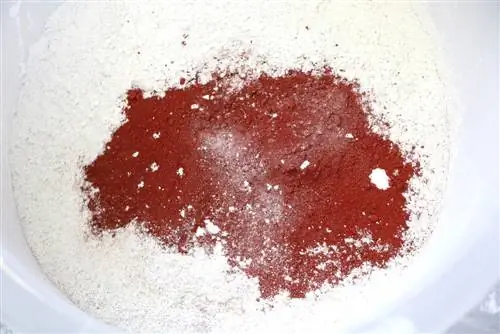
Regardless of the pigment described later, the concrete's ability to absorb the dyes is limited. As a rule, if the amount of cement is increased beyond five percent, there is no longer any noticeable change or intensification of the color. The concrete is therefore saturated. If lighter colors are to be achieved, the proportion can be reduced, so that pigment proportions between two and the ultimate upper limit of five percent are often used.
4. Efflorescence
All concrete releases a certain amount of s alts and other chemical compounds onto its surface over time. This is referred to as so-called blooming. This usually light to white layer causes the natural gray and added colors to appear brighter. The efflorescence can be removed with water pressure or sanding, but it can recur. As a result, concrete that initially appears deep black will, in most cases, eventually give way to anthracite or even very dark black-gray.
The processing
The pigments added to the concrete are always processed in the same way, regardless of the type of pigment:
- Determine the required concrete volume
- Determine the amount of cement for the concrete volume according to the manufacturer's instructions, taking aggregates (sand, gravel) into account
- Weigh the pigment according to the manufacturer's instructions in relation to the amount of cement
- If available, use the manufacturer's color chart to determine the pigment to cement ratio
- Mix pigment and dry cement thoroughly to avoid later paint pockets
- Create and process concrete in the usual form from a pigment-cement mixture, water and aggregates
ATTENTION:
Wearing safety glasses and a dust mask is recommended not only for the very fine pigment, but also for handling the harmful cement. The finest particles can enter the respiratory tract or eyes and cause permanent damage.
Common pigments
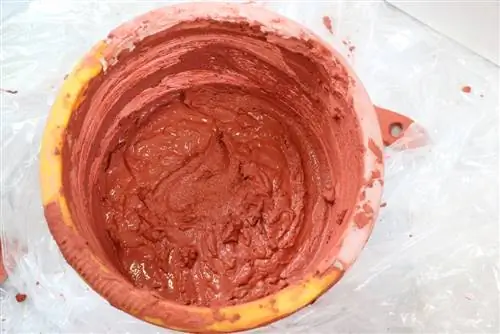
There are different pigments that can be used to color concrete. Here you will find the most common and practical ones.
Professional Pigments
Various manufacturers today offer targeted pigments for coloring concrete. The color palette is constantly increasing and now includes all common main colors. The gradation of the color tone, on the other hand, is controlled by the amount of pigment added.
Bas alt
The pigment of the same name, ground from bas alt rock, is available in art supplies. Although in its pure form the stone powder usually appears gray to olive green, in concrete it results in a strong black color. Depending on the dosage, colors ranging from anthracite to various shades of gray can also be achieved.
Copper Oxide
The copper oxide, also known in horticulture as a weed killer, can also be used as a pigment. Depending on the chemical composition, it usually produces green, rarely green-brown colors.
Iron oxide
Just as iron turns human blood red, in the form of iron oxide it is able to color concrete in ocher to brown-red tones. It is available from art supplies stores as well as numerous craft or chemical supply stores.
ATTENTION
You often read about coloring concrete dark to black by adding soot or charcoal powder. Although darkening is achieved in this way, these substances are organic compounds, so neither their durability nor the effect to be achieved are guaranteed. The durability of the concrete itself can also be affected by the addition of organic substances to its basic mineral substances. At this point, we strongly advise against using charcoal or soot to color concrete!
Special case of oil shale cement
If you are aiming for a reddish-brown color, you can use a special cement, the so-called oil shale cement, instead of additional pigments. Instead of normal marl, this is made from oil shale, ultimately a special form of clay and limestone. It produces a reddish-brown hue on its own but is more expensive than regular cement in terms of cost. Here it is important to weigh up the cheaper option before buying - oil shale cement or normal cement with pigments.
Coloring with additives - the alternative
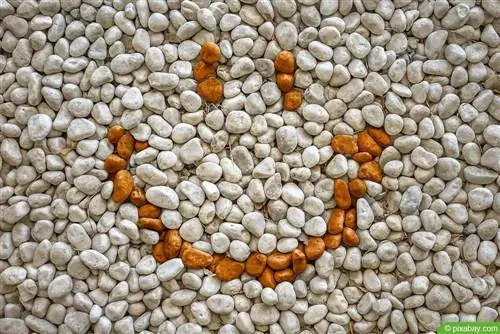
Instead of coloring the cement and thus the core element of the concrete, there is another way to influence the color. Today there are a variety of different types of gravel and gravel that vary greatly in color. The technical suitability of these types of gravel is hardly relevant, especially for concrete that is subject to less stress, such as in the area of horticulture. Instead, choosing a strong, intense color can create a clear contrast to the gray of the concrete. How about, for example, deep black or pure white gravel in the gray of the cement? While the colors can be easily distinguished up close, the human eye mixes them together from a distance and achieves a uniform blend of both colors.
Pigmented glazes
Finally, the possibility of coloring existing concrete components using glazes containing pigment should be briefly discussed here. The manufacturers of these products rely on the fact that the pigments penetrate into the depths of the material due to the suction effect of the concrete pores and thus actually color the concrete. However, since the penetration depth is very limited, long-term observations show that this is ultimately a very durable surface coating, which in the actual sense is not one of the options for coloring concrete.

